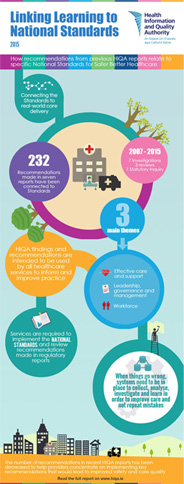HIQA publishes guide to linking learning to National Standards
The Health Information and Quality Authority (HIQA) has today published new guidance to help hospitals and healthcare providers improve quality and safety by linking recommendations — from previous HIQA investigations and reviews into healthcare services — with National Standards that they are expected to meet.
Following seven investigations, a statutory inquiry and three reviews, HIQA has in recent years produced a large amount of corrective actions for public health services in Ireland. Linking learning to National Standards connects National Standards to real-world care delivery by matching recommendations to identified standards.
Mary Dunnion, HIQA’s Director of Regulation, commented: “We took seven reports that we have published into the quality and safety of healthcare services between 2009 and 2015 and connected each of the 232 recommendations in these reports with an overarching National Standard from our National Standards for Safer Better Healthcare.

“The objective is to show healthcare providers real examples of how particular standards can be met. If they are confident they are meeting the national standards, they can also be assured that they are meeting recommendations linked to these national standards. While risk cannot be eliminated entirely, people responsible for planning, resourcing, managing and delivering healthcare have a duty to protect patients and service users as far as reasonably practicable from the risk of harm. This includes taking measures to avoid any unnecessary risk and creating a culture of learning from patient-safety incidents.
“Findings and recommendations of HIQA investigations and reviews are intended to be used by all healthcare services to inform and improve practice. We identified 32 out of the 45 National Standards in our various recommendations. We found recommendations are repeatedly associated with the same National Standards, mainly in the areas of Effective Care and Support; Leadership, Governance and Management; and Workforce. The relevant Standard needs to be implemented across the wider healthcare system.”
High-quality, safe and reliable healthcare is delivered through services that are well defined and communicated, and which are supported by good governance. The delivery of care should be based on best available evidence, and performance should be monitored continuously to check if a service meets National Standards. When things go wrong, or desired outcomes are not achieved, there needs to be systems in place to collect, analyse, investigate and learn so that care is improved and mistakes are not repeated.
Mary Dunnion concluded: “Service providers are required to review recommendations made in regulatory reports, and determine the relevance of them to their service. A key factor in this process involves service providers assessing their service against not only the relevant recommendation but also the related overarching National Standard or Standards. This guidance is aimed at grounding the experiences of people and staff involved in poor outcomes into the National Standards, and aiding healthcare services to ensure they meet standards of care that would minimise such events happening again.”
Further Information:
Suzanne O’Brien, Communications Manager, HIQA
01 814 7488 / 087 624 1216 sobrien@hiqa.ie
Notes to the Editor:
The National Standards for Safer Better Healthcare were published in 2012. The HIQA guidance looked at recommendations in:
- Report of the investigation into the quality and safety of services and supporting arrangements provided by the Health Service Executive at the Mid-Western Regional Hospital Ennis (2009).
- Report of the investigation into the quality and safety of services and supporting arrangements provided by the Health Service Executive at Mallow General Hospital (2011).
- Report of the Inquiry into the circumstances that led to the failed transportation of Meadhbh McGivern for transplant surgery and the existing inter-agency arrangements in place for people requiring emergency transportation for transplant surgery (2011).
- Report of the investigation into the quality, safety and governance of the care provided by the Adelaide and MeathHospital, Dublin incorporating the National Children’s Hospital (AMNCH) for patients who require acute admission (2012).
- Investigation into the safety, quality and standards of services provided by the Health Service Executive to patients, including pregnant women, at risk of clinical deterioration, including those provided in University Hospital Galway, and as reflected in the care and treatment provided to Savita Halappanavar (2013).
- Review of pre-hospital emergency care services to ensure high quality in the assessment, diagnosis, clinical management and transporting of acutely ill patients to appropriate healthcare facilities (2014).
- Report of the investigation into the safety, quality and standards of services provided by the Health Service Executive to patients in the Midland Regional Hospital, Portlaoise (2015).
Findings included:
- 22 recommendations in all seven reports relating to the importance of the correct model of care (this represented 9% of all 232 recommendations)
- 14 recommendations relating to the importance of integrated care
- 40 recommendations were about the need for formalised accountability and governance arrangements
- 14 recommendations relating to management arrangements and eight linked to workforce competencies.
- 16 recommendations in four reports related to evidence-based healthcare
- 16 recommendations relating to standards on monitoring effectiveness of care
- 14 recommendations on systematic monitoring arrangements for identifying and acting on opportunities to improve care
- 19 recommendations in all seven reports relating to the standard on acting on recommendations of investigations.
The number of recommendations in recently published HIQA investigation and review reports has been decreased by the Authority. This is aimed at putting a stronger focus on the important issues that arise from findings and to help service providers concentrate on implementing key recommendations that would lead to improved safety and quality of care for patients.
Ends